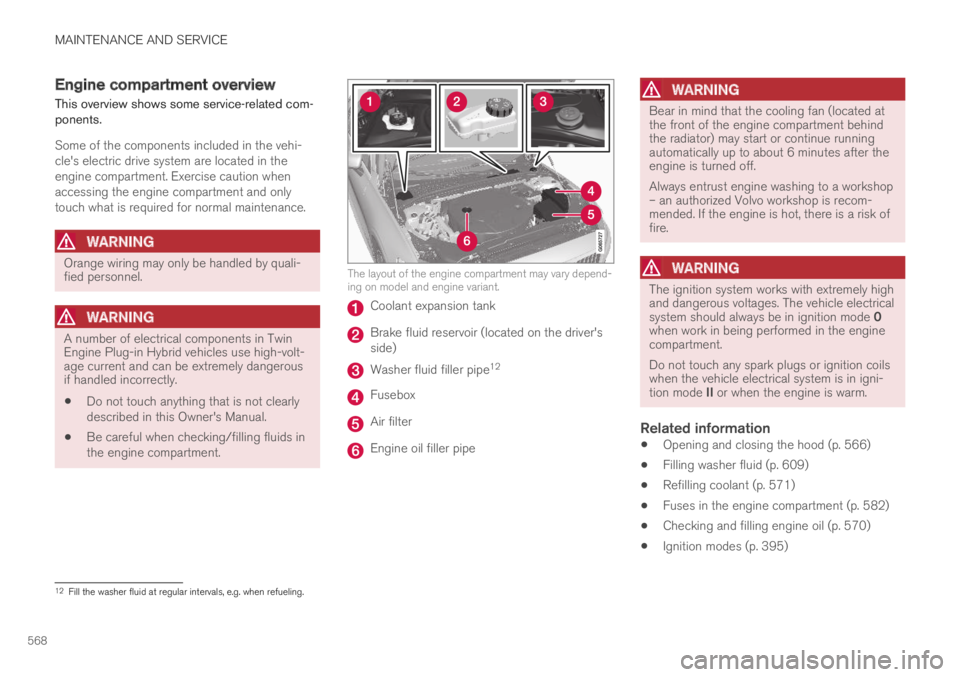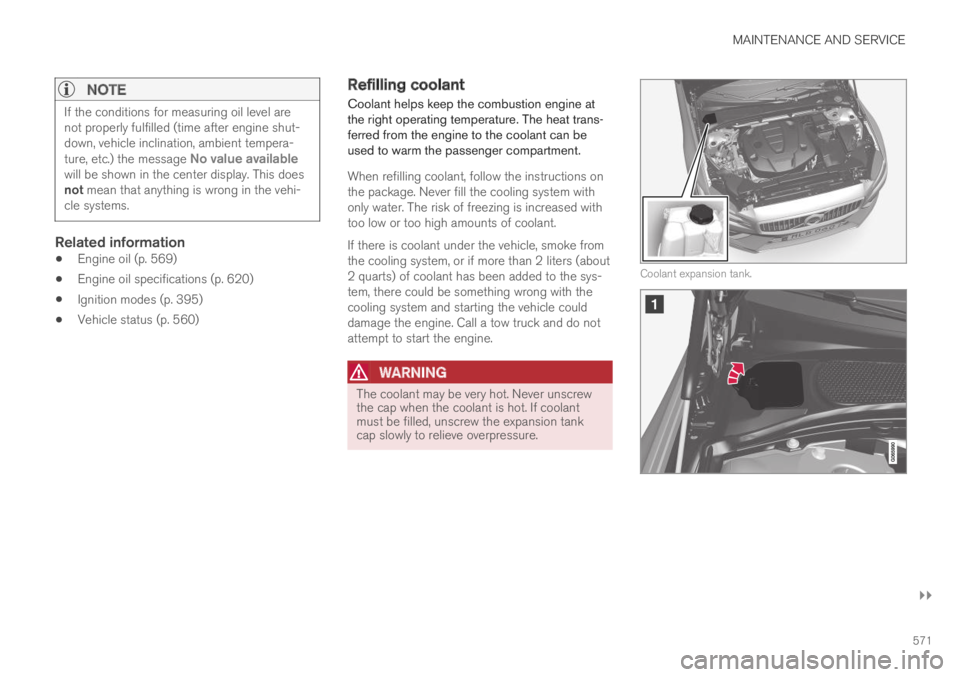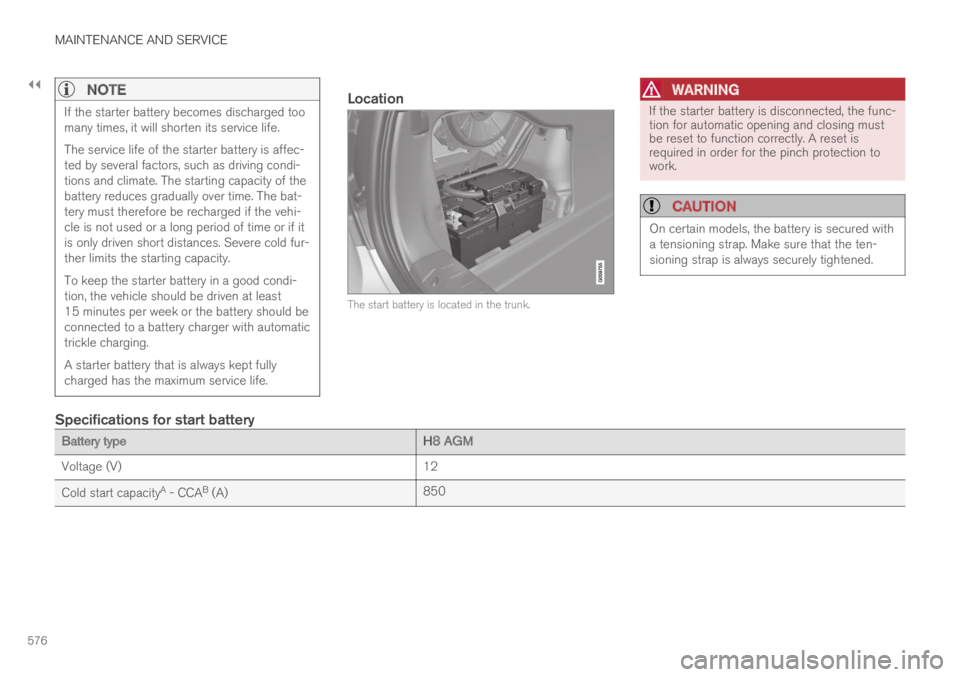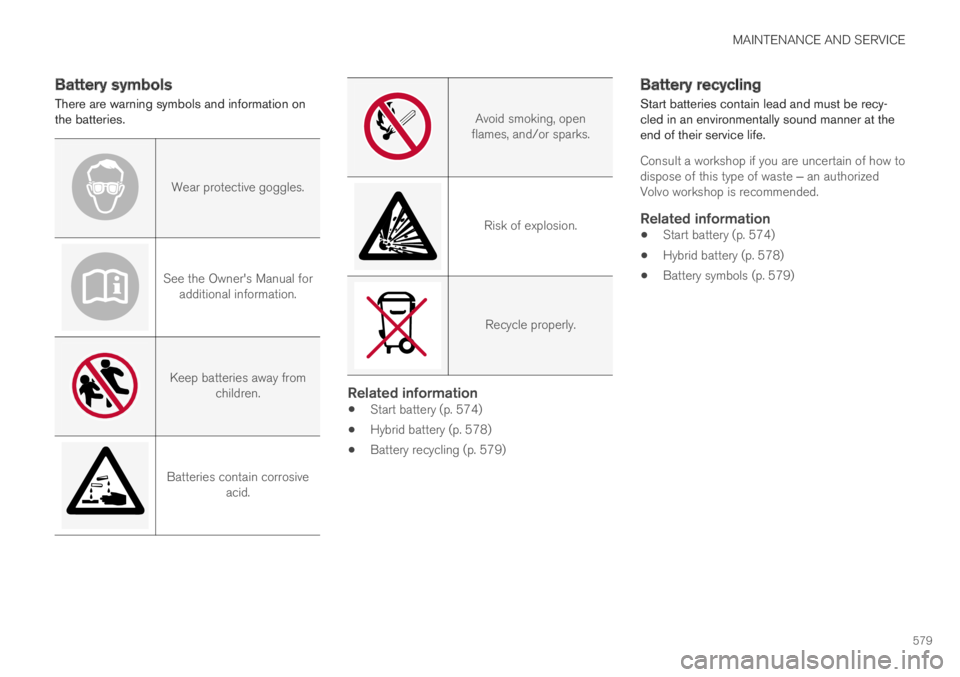warning VOLVO S60 TWIN ENGINE 2019 Owners Manual
[x] Cancel search | Manufacturer: VOLVO, Model Year: 2019, Model line: S60 TWIN ENGINE, Model: VOLVO S60 TWIN ENGINE 2019Pages: 645, PDF Size: 13.96 MB
Page 569 of 645

MAINTENANCE AND SERVICE
567
Swipe your hand from left to right under thehood, grasp the handle and move it up and tothe side to release the catch and lift thehood.
Warning - hood not closed
When the hood is released, a warningsymbol and graphic will be displayed inthe instrument panel and an audiblesignal will sound. If the vehicle beginsto roll, the audible signal will be repeated severaltimes.
NOTE
If the warning symbol is illuminated or anaudible warning signal sounds even thoughthe hood is securely closed, consult a work-shop - an authorized Volvo workshop is rec-ommended.
Closing the hood
1. Press down the hood until it begins to closeunder its own weight.
2. When the hood reaches the catch at thehandle in the front edge of the vehicle, pressdown on the hood to close it completely.
WARNING
Risk of injury! When closing, make sure thatthe hood is completely unobstructed and thatno one can be injured.
WARNING
Make sure the hood locks securely after clos-ing. It must audibly lock on both sides.
Hood not completely closed.
Hood completely closed.
WARNING
Never drive with the hood open!
If there are any indications while driving thatthe hood is not completely closed, stop imme-diately and close it securely.
Related information
Engine compartment overview (p. 568)
Door and seat belt reminders (p. 51)
Page 570 of 645

MAINTENANCE AND SERVICE
568
Engine compartment overview
This overview shows some service-related com-ponents.
Some of the components included in the vehi-cle's electric drive system are located in theengine compartment. Exercise caution whenaccessing the engine compartment and onlytouch what is required for normal maintenance.
WARNING
Orange wiring may only be handled by quali-fied personnel.
WARNING
A number of electrical components in TwinEngine Plug-in Hybrid vehicles use high-volt-age current and can be extremely dangerousif handled incorrectly.
Do not touch anything that is not clearlydescribed in this Owner's Manual.
Be careful when checking/filling fluids inthe engine compartment.
The layout of the engine compartment may vary depend-ing on model and engine variant.
Coolant expansion tank
Brake fluid reservoir (located on the driver'sside)
Washer fluid filler pipe12
Fusebox
Air filter
Engine oil filler pipe
WARNING
Bear in mind that the cooling fan (located atthe front of the engine compartment behindthe radiator) may start or continue runningautomatically up to about 6 minutes after theengine is turned off.
Always entrust engine washing to a workshop– an authorized Volvo workshop is recom-mended. If the engine is hot, there is a risk offire.
WARNING
The ignition system works with extremely highand dangerous voltages. The vehicle electricalsystem should always be in ignition mode 0when work in being performed in the enginecompartment.
Do not touch any spark plugs or ignition coilswhen the vehicle electrical system is in igni-tion mode II or when the engine is warm.
Related information
Opening and closing the hood (p. 566)
Filling washer fluid (p. 609)
Refilling coolant (p. 571)
Fuses in the engine compartment (p. 582)
Checking and filling engine oil (p. 570)
Ignition modes (p. 395)
12Fill the washer fluid at regular intervals, e.g. when refueling.
Page 571 of 645

MAINTENANCE AND SERVICE
569
Engine oil
For the recommended service intervals and war-ranties to be applied, an approved engine oilmust be used.
Volvo recommends:
If the engine oil is not checked regularly and thelevel becomes low, this could cause seriousengine damage.
CAUTION
To satisfy the requirements for the engine'sservice intervals, all engines are factory-filledwith a specially adapted synthetic engine oil.Great care has been put into the choice of oil,with consideration given to service life, starta-bility, fuel consumption and environmentalimpact.
For the recommended service intervals toapply, an approved engine oil must be used.Only use the prescribed oil grade to top off orchange the oil. Otherwise, there is a risk ofthe vehicle's service life, startability, fuel con-sumption and environmental impact beingaffected.
Failure to use engine oil of the prescribedgrade and viscosity could cause damage toengine-related components. Volvo Car Corpo-ration disclaims warranty liability for such typeof damage.
Volvo recommends entrusting oil changes toan authorized Volvo workshop.
Volvo uses different systems to warn if the oillevel is too low/high or the oil pressure is low. Onengine variants with an oil pressure sensor, a
warning symbol is displayed in the instrument
panel when oil pressure is low . On engine
variants with an oil level sensor, the warn-ing symbol in the instrument panel and displaymessages are used to alert the driver. Someengine variants have both systems. Contact aVolvo retailer for more information.
Change the engine oil and oil filter according tothe schedule specified in the Warranty and Main-tenance Records Information booklet. Oils of ahigher grade than that specified may be used. Ifthe vehicle is driven in adverse conditions, Volvorecommends using an oil with a higher gradethan that specified.
Related information
Checking and filling engine oil (p. 570)
Engine oil specifications (p. 620)
Page 572 of 645

MAINTENANCE AND SERVICE
570
Checking and filling engine oil
The engine oil level is monitored by an electronicoil level sensor.
Filler pipe13.
It may be necessary to top up engine oil betweenregularly scheduled services.
No action is necessary with regard to engine oillevel until a message appears in the instrumentpanel.
WARNING
If this symbol is shown togetherwith the message Engine oil levelService required, visit a workshop– an authorized Volvo workshop isrecommended. The oil level may be too high.
CAUTION
If this symbol is shown togetherwith a message about low oil level,for example Engine oil level lowRefill 1 liter, fill only with the indi-cated volume, e.g. 1 liter (1 quart).
WARNING
Do not spill oil on the hot exhaust pipes asthis could cause a fire.
Viewing oil level in the center display
The oil level can be viewed using the electronicoil level gauge in the center display once thevehicle has been started. The oil level should bechecked regularly.
1.Open the Car Status app from App view inthe center display.
2.Tap Status to display the oil level.
Oil level graphic in the center display.
NOTE
The system cannot directly detect changeswhen the oil is filled or drained. The vehiclemust have been driven approximately 30 km(20 miles) and have been stationary5 minutes on a level surface and with theengine off before the correct oil level will bedisplayed.
13Engines with an electronic oil level sensor do not have a dipstick.
Page 573 of 645

MAINTENANCE AND SERVICE
}}
571
NOTE
If the conditions for measuring oil level arenot properly fulfilled (time after engine shut-down, vehicle inclination, ambient tempera-ture, etc.) the message No value availablewill be shown in the center display. This doesnot mean that anything is wrong in the vehi-cle systems.
Related information
Engine oil (p. 569)
Engine oil specifications (p. 620)
Ignition modes (p. 395)
Vehicle status (p. 560)
Refilling coolant
Coolant helps keep the combustion engine atthe right operating temperature. The heat trans-ferred from the engine to the coolant can beused to warm the passenger compartment.
When refilling coolant, follow the instructions onthe package. Never fill the cooling system withonly water. The risk of freezing is increased withtoo low or too high amounts of coolant.
If there is coolant under the vehicle, smoke fromthe cooling system, or if more than 2 liters (about2 quarts) of coolant has been added to the sys-tem, there could be something wrong with thecooling system and starting the vehicle coulddamage the engine. Call a tow truck and do notattempt to start the engine.
WARNING
The coolant may be very hot. Never unscrewthe cap when the coolant is hot. If coolantmust be filled, unscrew the expansion tankcap slowly to relieve overpressure.
Coolant expansion tank.
Page 576 of 645

MAINTENANCE AND SERVICE
574
Start battery
The vehicle has a single-pole electrical systemthat uses the chassis and engine mount as con-ductors.
The start battery is used to start the electricalsystem and power electrical equipment in thevehicle. The hybrid battery is used to start thecombustion engine.
The start battery should only be replaced by a
workshop17.
The start battery is a 12 V AGM (Absorbed GlassMat) battery, dimensioned for regenerative charg-ing and to support the function of the vehicle'svarious systems.
The service life and performance of the start bat-tery are affected by factors such as driving style,driving conditions, climate, battery discharges,number of starts, etc.
Never disconnect the start battery while theengine is running.
Make sure the cables to the start battery arecorrectly connected and the clamps aresecurely tightened.
WARNING
Batteries generate hydrogen gas, whichis flammable and explosive.
Do not connect the jumper cable to anypart of the fuel system or to any movingparts. Avoid touching hot manifolds.
Battery fluid contains sulfuric acid. Do notallow battery fluid to contact eyes, skin,fabrics or painted surfaces.
If contact occurs, flush the affected areaimmediately with water. Obtain medicalhelp immediately if eyes are affected.
Never expose the battery to open flameor electric spark. Do not smoke near thebattery. Failure to follow the instructionsfor jump starting can lead to injury.
Connection points
WARNING
California Proposition 65
Operating, servicing and maintaining a pas-senger vehicle can expose you to chemicalsincluding engine exhaust, carbon monoxide,phthalates, and lead, which are known to theState of California to cause cancer and birthdefects or other reproductive harm. To mini-mize exposure, avoid breathing exhaust, donot idle the engine except as necessary, serv-ice your vehicle in a well ventilated area andwear gloves or wash your hands frequentlywhen servicing your vehicle. For more infor-mation go to www.P65Warnings.ca.gov/passenger-vehicle.
Use the vehicle's connection points in the enginecompartment to connect an external start batteryor battery charger.
The battery terminals on the car's start battery inthe luggage/cargo area must not be used.
17An authorized Volvo workshop is recommended.
Page 578 of 645

||
MAINTENANCE AND SERVICE
576
NOTE
If the starter battery becomes discharged toomany times, it will shorten its service life.
The service life of the starter battery is affec-ted by several factors, such as driving condi-tions and climate. The starting capacity of thebattery reduces gradually over time. The bat-tery must therefore be recharged if the vehi-cle is not used or a long period of time or if itis only driven short distances. Severe cold fur-ther limits the starting capacity.
To keep the starter battery in a good condi-tion, the vehicle should be driven at least15 minutes per week or the battery should beconnected to a battery charger with automatictrickle charging.
A starter battery that is always kept fullycharged has the maximum service life.
Location
The start battery is located in the trunk.
WARNING
If the starter battery is disconnected, the func-tion for automatic opening and closing mustbe reset to function correctly. A reset isrequired in order for the pinch protection towork.
CAUTION
On certain models, the battery is secured witha tensioning strap. Make sure that the ten-sioning strap is always securely tightened.
Specifications for start battery
Battery typeH8 AGM
Voltage (V)12
Cold start capacityA - CCAB (A)850
Page 580 of 645

MAINTENANCE AND SERVICE
578
Hybrid battery
The vehicle's electric motor is powered by arechargeable, maintenance-free, lithium-ionhybrid battery.
NOTE
The vehicle cannot be started if the hybridbattery is discharged.
NOTE
If both the starter battery and the hybrid bat-tery are discharged, both batteries must becharged. In such cases, it is not possible tocharge only the hybrid battery first.
The starter battery must have a certain levelof charge for it to be possible to charge thehybrid battery.
WARNING
Hybrid battery replacement may only be per-formed by a workshop – an authorized Volvoworkshop is recommended.
Coolant
The hybrid battery's cooling system has its ownexpansion tank.
CAUTION
Filling the hybrid battery coolant should onlybe performed by a workshop – an authorizedVolvo workshop is recommended.
Specifications for hybrid battery
Type: Lithium-ion
Power reserve: 10.4 kWh.
NOTE
The capacity of the hybrid battery decreaseswith age and use, which could result inincreased use of the combustion engine,leading to higher fuel consumption andreduced electric motor range.
Related information
Battery symbols (p. 579)
Start battery (p. 574)
Charging the hybrid battery (p. 375)
Battery recycling (p. 579)
Page 581 of 645

MAINTENANCE AND SERVICE
579
Battery symbols
There are warning symbols and information onthe batteries.
Wear protective goggles.
See the Owner's Manual foradditional information.
Keep batteries away fromchildren.
Batteries contain corrosiveacid.
Avoid smoking, openflames, and/or sparks.
Risk of explosion.
Recycle properly.
Related information
Start battery (p. 574)
Hybrid battery (p. 578)
Battery recycling (p. 579)
Battery recycling
Start batteries contain lead and must be recy-cled in an environmentally sound manner at theend of their service life.
Consult a workshop if you are uncertain of how todispose of this type of waste ‒ an authorizedVolvo workshop is recommended.
Related information
Start battery (p. 574)
Hybrid battery (p. 578)
Battery symbols (p. 579)
Page 582 of 645

MAINTENANCE AND SERVICE
580
Fuses and fuseboxes
All electrical functions and components are pro-tected by a number of fuses in order to protectthe vehicle's electrical system from damage byshort circuiting or overloading.
WARNING
Never use a foreign object or a fuse with ahigher amperage than that specified toreplace a fuse. This could cause significantdamage to the electrical system and possiblylead to a fire.
WARNING
Orange wiring may only be handled by quali-fied personnel.
WARNING
A number of electrical components in TwinEngine Plug-in Hybrid vehicles use high-volt-age current and can be extremely dangerousif handled incorrectly.
Do not touch anything that is not clearlydescribed in the vehicle's Owner's Manual.
If any electrical component or function is notresponding, the component may have blown afuse due to temporary overload. If the same fuseblows repeatedly, there may be a problem withthe component. Volvo recommends contacting an
authorized Volvo workshop to have the compo-nent checked.
Location of fuseboxes
The illustration is generic - appearance may vary accord-ing to vehicle model.
Engine compartment
Under the glove compartment
Trunk/cargo compartment
Related information
Replacing fuses (p. 580)
Fuses in the trunk (p. 589)
Fuses in the engine compartment (p. 582)
Fuses under the glove compartment(p. 586)
Replacing fuses
All electrical functions and components are pro-tected by a number of fuses in order to protectthe vehicle's electrical system from damage byshort circuiting or overloading.
1. Refer to the fuse diagram to locate the fuse.
2.Pull out the fuse and examine it from theside to determine if the curved metal wire inthe fuse is intact.
3. If the wire is broken, replace the fuse with anew fuse of the same color and amperage.
WARNING
Never use a foreign object or a fuse with ahigher amperage than that specified toreplace a fuse. This could cause significantdamage to the electrical system and possiblylead to a fire.
WARNING
Contact an authorized Volvo workshop forassistance replacing fuses not listed in theOwner's Manual. If performed incorrectly, sig-nificant damage can be caused to the electri-cal system.
Related information
Fuses and fuseboxes (p. 580)
Fuses in the trunk (p. 589)